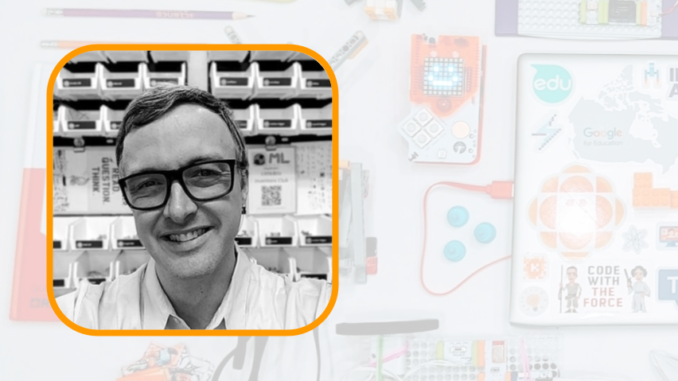
By Kristofor Schuermann
For over a decade, I have had the privilege of working in Peel Region school libraries with students from early years to the senior level. During this time, I have been able to develop my pedagogy around the idea of maker education. This mindset is meant to build an atmosphere of creative and innovative inquiry to help modern learners be curious, make new discoveries, develop skills, build solutions, and showcase their ideas. These makers learn from failure and are intrinsically motivated to strive for high expectations through voice, choice, agency and ownership.
Many tools enhance a student’s ability to make personalized artifacts to help them best convey their message or discoveries. MakerSpaces can be filled with yarn, 3D printers, wood, cameras, robots, cardboard, and tablet computers, as it gives students options and resources to help them build products that demonstrate their learning, their way. Developing a student’s capacity to be build creative, digital media for example, has proven a very powerful pathway to empowering modern learners with agency and ownership.
Early examples of nurturing a student’s ability to broadcast their ideas came when working with the Caped Crusaders Comic Book Club, starting in 2009. This extracurricular group of grade four and grade five students was built on a passion for all things visual literacy. Along with expressive read-alouds and drawing workshops, advocacy and awareness was a big part of our work to help change misconceptions around the value of graphic novels in academic settings. Year after year, the group embraced new digital media forms, and were eager to explore and create. Members of the group would create a vast catalogue of graphic novel reviews which were posted on our website, and short hype videos recorded and linked via QR code on the back of library titles. Students developed several ‘Seven Second Synopsis’ videos to spread the word; acting out fast, dramatic takes while sprinting through the content of their favourite comics on the now defunct Vine social media platform. The most impact came through several podcasts we co-created. The production of just a few complete episodes was difficult, but through shared work and intrinsic motivation, we were able to publish the podcast in early 2015. Student members owned the direction of the podcast, planning and recording content for their segments that could be slotted together depending on the upcoming theme. When an episode was published on our site, global metrics showed thousands of listeners and affirmed their work. It was definitely hard fun, but the students advocated for the direction and owned the content.
Listen to Episode 1 of Caped Crusader Comic Book Club Podcast
When given the privilege to open the new Aylesbury Public School library learning commons in September 2015, we were able to intentionally build a space with purposeful tools and in consultation with students in the community. With the help of ‘global competency’ focused design challenges & MakerSpace extracurriculars, I continued to help guide and nurture modern learners in developing hard skills around digital media production. Primary students used a scaffolded pathway to independently create stop-motion films used to demonstrate their understanding of three-part narratives & procedures. Junior-level Caped Crusaders built graphic novel, quick cut green-screen films to promote their favourite comics. Grade 6 students built videos through interactive whiteboards to document their conservations, observation and products while working through a large-scale inquiry around outer-space exploration. Intermediate students used sound engineering software to record beat-boxing tracks & to dramatically narrate their chroma-key films. Grade 7 students also used a visual-programming language to make intentional, empathy driven computer programs for grade 1 ‘clients’. All this work provided modern learners with an array of transferable digital media options to share what they had learned.
View the grade 1 stop-motion film, the Robot Problem
Click here to view an example of a grade 6 film documenting learning
Several special examples of student voice using digital film production happened with the MegaBrights. This equity of access and empowerment extracurricular group gave a pathway to young women to lead many of our school’s MakerSpace initiatives. Members of the group had unlimited access to innovative tools & operated under an open-inquiry model using the UN Global Goals as a guide. I would consistently advocate to members to document their excellent work, especially when they took part in regional or global competitions they decided to pursue. One group of MegaBrights developed a LittleBits robot designed specifically for their brother’s with ASD so they would stay calm and be able to stay in class. Another group of intermediate MegaBrights went through an extensive Design Thinking process to create a personal safety Android APP prototype that promoted safe and equitable community access at any time. Both groups directed and produced chroma-key ‘hype videos’ to promote their creations for the global competitions they were involved with, with great success.
View the LittleBits ‘ASD Droid’ Hype Video
View the Android ‘Walk Bright’ Technovation Hype Video
Moving online during the global pandemic provided an excellent opportunity to shift to web-based digital media pathways that would provide students with the agency to choose the best ways of showcasing their ideas no matter what type of computer they had access too. Simple slide show programs, such as Google Slides and Microsoft PowerPoint, were leveraged to produce a wide variety of outside-of-the-box productions. Choose-Your-Own Adventure stories, APP prototyping, digital breakout games, comic books and stylized infographics were examples of products we taught learners to produce to give them choices on how to best represent their thinking.
View a tutorial on using Google Slides to produce Infographics
View a tutorial on using Google Slides to produce Comic Books
This brings us back to the point of empowering learners with options to showcase what they have learned, and feel is important others know about. Students with a digital toolbox of media design ideas have the agency and ownership to create, remix, and rethink how they tell the world all about what they have discovered. Modern learners could design media that speaks to their strengths and artistic abilities, or they could purposefully & empathetically design media for an intended audience that needs information in a certain format. If makers are empowered with the skills & the agency to use them when needed, they can see themselves as Changemakers able to take action in their daily world.

Kristofor Schuermann has worked as a children’s librarian for the Caledon public library system & as a teacher-librarian in Mississauga and Brampton. Kristofor is employed by the Peel District School Board, and is currently part of the central Empowering Modern Learners innovation team bringing progressive pedagogy & inspiring learning pathways to students and schools. Kristofor is an advocate for the value of the Library Learning Commons & the positive impact of meaningful maker education. Read more by clicking here & please follow him on Twitter at @MrSchuermann.